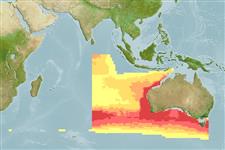Classification / Names
Common names | Synonyms | Catalog of Fishes (gen., sp.) | ITIS | CoL | WoRMS | Cloffa
Elasmobranchii (sharks and rays) >
Carcharhiniformes (Ground sharks) >
Scyliorhinidae (Cat sharks)
Etymology: Asymbolus: Greek, assymbolos, -os, -on = uselees, free, alone (Ref. 45335); parvus: From its small relative size within the genus.. More on author: Last.
Environment / Climate / Range
Ecology
Marine; pelagic-oceanic; depth range 160 - 260 m (Ref. 36712). Subtropical, preferred ?
Eastern Indian Ocean: Western Australia.
Size / Weight / Age
Maturity: Lm ? range ? - ? cm
Max length : 34.9 cm TL male/unsexed; (Ref. 36712); 35.7 cm TL (female)
Short description
Morphology | Morphometrics
Very small, distinctive, pale brown body with many white spots and blotches; dark brown or black spots absent. Caudal peduncle relatively thin; low anal fin. Preoral length long. Teeth very small, ridged with 5-7 cusps; small, densely imbricated, weakly tricuspidate denticles. Monospondylous centra 34-35.
Life cycle and mating behavior
Maturity | Reproduction | Spawning | Eggs | Fecundity | Larvae
Oviparous, paired eggs are laid. Embryos feed solely on yolk (Ref. 50449).
Compagno, L.J.V., J.D. Stevens and P.R. Last, 1999. Australian spotted catsharks of the genus Asymbolus (Carcharhiniformes: Scyliorhinidae). Part 1: Descriptions of three new species from western Australia. p. 2-18. In P.R. Last (ed.). Australian catsharks of the genus Asymbolus (Carcharhiniformes: Scyliorhinidae). (Ref. 36712)
IUCN Red List Status (Ref. 115185)
CITES (Ref. 94142)
Not Evaluated
Threat to humans
Harmless
Human uses
More information
Age/SizeGrowthLength-weightLength-lengthLength-frequenciesMorphometricsMorphologyLarvaeLarval dynamicsRecruitmentAbundance
ReferencesAquacultureAquaculture profileStrainsGeneticsAllele frequenciesHeritabilityDiseasesProcessingMass conversion
Tools
Special reports
Download XML
Internet sources
